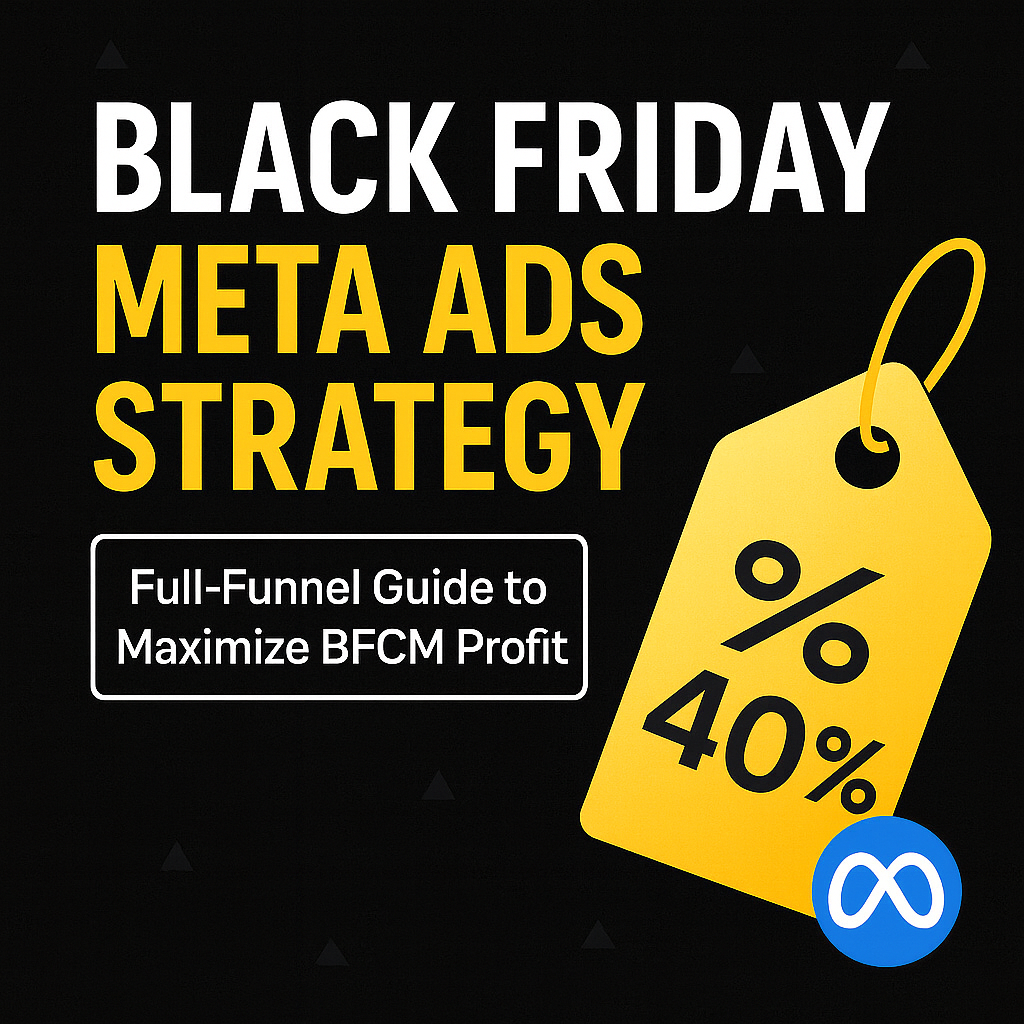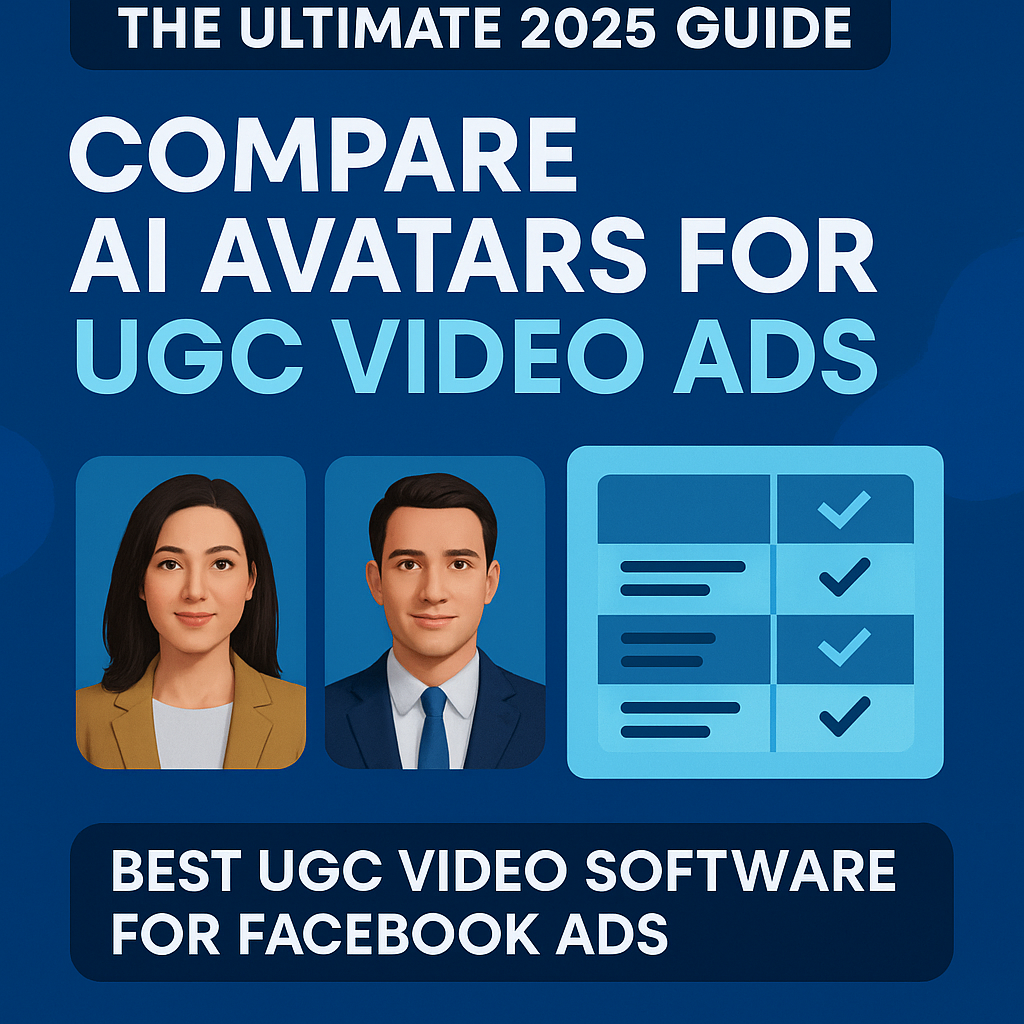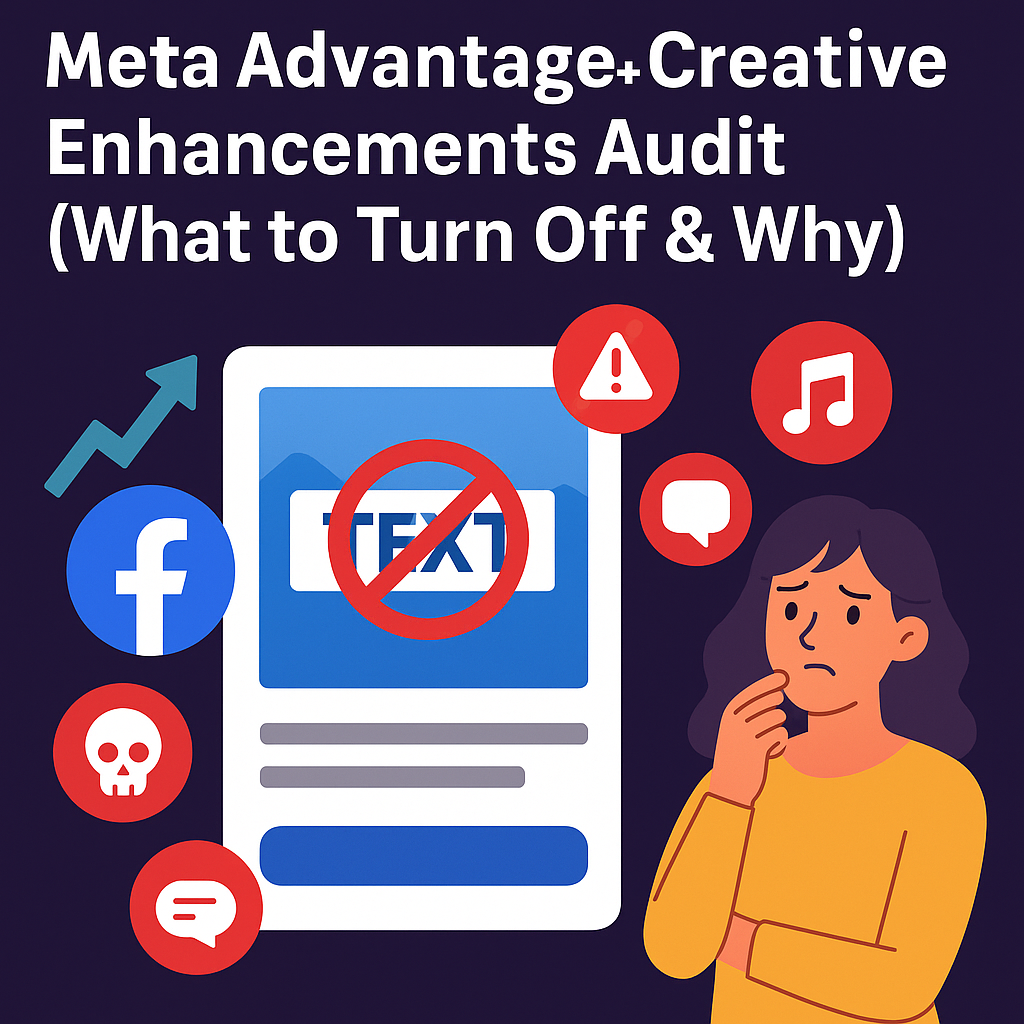In the competitive world of ad copywriting, capturing your audience’s attention is crucial for increasing conversions. With many brands competing for limited attention, your ad copy must be more than just persuasive — it needs to be crystal clear. But what if the key to higher conversions isn’t about using fancy words or complex sentences? What if it’s as simple as writing at an eighth-grade reading level?
That’s right. Research shows that simpler language in your ad copy can significantly boost engagement and drive sales—especially for ecommerce and DTC brands. In this guide, we’ll dive into the why and how of readability, explore proven ad copywriting formats and marketing angles, provide ecommerce copywriting tips, share headline formulas, and offer a practical framework for writing digital ad copy that converts.
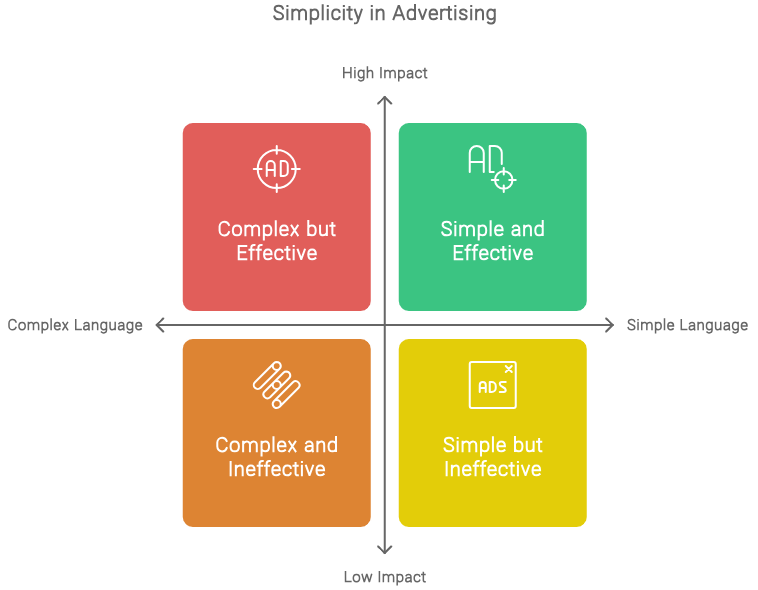
Table of Contents
What Is Ad Copywriting?
Ad copywriting is the craft of writing short-form persuasive messages designed to trigger action, from clicking a link to buying a product. It spans across Facebook ads, TikTok videos, YouTube pre-rolls, Google search ads, and landing pages. Great ad copy grabs attention, builds desire, and ends with a clear next step. Whether you’re writing digital ad copy for a startup, local service, or ecommerce brand, the goal remains the same: clarity and conversion.
Why Simplicity in Ad Copy Matters
Think about the last time you scrolled through your Facebook feed or browsed an online store. How much time did you spend actually reading the ads? Probably not much. In today’s fast-paced digital world, attention spans are shorter than ever. Studies suggest that the average online attention span is a mere 8 seconds—less than that of a goldfish!
This is where readability comes in. Readability formulas, like the Flesch-Kincaid Grade Level and the Gunning Fog Index, measure the complexity of your writing. Lower scores indicate easier-to-read text. And when it comes to ad copy that converts, easier almost always equals better.
Successful microbrands like Death Wish Coffee and Allbirds have mastered this. Death Wish Coffee uses straightforward, bold messaging to communicate its product’s strength. At the same time, Allbirds emphasizes comfort and sustainability in a way anyone can grasp. Both brands have snowballed by focusing on clear, relatable messaging.
Why? Because simple language enhances cognitive fluency, the ease with which our brains process information. When your ad copy is clear and concise, readers can quickly understand your message without expending much mental effort. This leads to better comprehension, increased trust, and a higher likelihood of taking action.
Let’s look at an example. Imagine you’re selling a new line of organic skincare products. Which ad copy is more likely to grab attention and drive clicks?
✅ “Get glowing skin naturally with our new organic skincare. Shop now and feel the difference!”.
❌ “Experience the rejuvenating power of nature with our meticulously crafted, organic skincare line, featuring potent botanical extracts and sustainably sourced ingredients.”
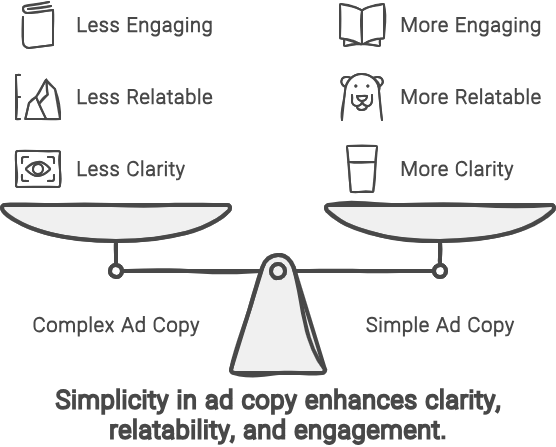
The Power of Simple Language for Persuasion
Now, you might be thinking, “But won’t simplifying my ad copy make it less persuasive?” Quite the contrary. Simple language can actually enhance your persuasive power by:
- Building Trust: Clear and straightforward language conveys honesty and transparency, making your brand appear more trustworthy.
- Highlighting Benefits: When you use simple language, you can focus on the key benefits of your product or service without getting bogged down in technical jargon.
- Strengthening Your Call to Action: A concise and easily understood call to action (e.g., “Shop Now,” “Learn More”) is more likely to prompt the desired action.
Take Dollar Shave Club, for example. Their ad copy is legendary for its humor and simplicity. Instead of bombarding customers with technical details about razor blades, they focus on the core benefits: affordable, high-quality razors delivered to your door. This clear and direct approach has helped them build a massive following and disrupt the shaving industry.
Finding the Right Reading Level for Your Audience
While writing at an 8th-grade reading level is a good general guideline, the ideal reading level for your ad copy can vary depending on your target audience. Consider factors like:
- Demographics: Age, education level, and cultural background can all influence reading comprehension.
- Interests: The reading level of your ad copy should align with the typical reading level of content consumed by your target audience.
- Industry: If you’re in a highly technical industry, you may need to use more specialized language, but always strive for clarity.
To determine the readability of your ad copy, you can use free online tools like the Hemingway Editor. These tools analyze your text and provide suggestions for simplification. You can also conduct A/B testing to see how different reading levels affect your ad performance.gestions for simplification. You can also conduct A/B testing to see how different reading levels affect your ad performance.
How to Write High-Converting Ad Copy (Step-by-Step)
- Start with your offer – What problem does it solve?
- Understand your customer – What do they care about?
- Write your hook – Grab attention with a bold, specific statement.
- Explain the benefit – Focus on results, not features.
- Add trust elements – Social proof, reviews, guarantees.
- Close with a CTA – Clear, compelling, and action-oriented.
Pro tip: Write 5–10 variations and test them all. The winner may surprise you.
Popular Ad Copywriting Formats (And When to Use Them)
While readability is crucial, it’s not the only factor that contributes to ad copy success. Here are some other essential elements to consider:
- Lo-Fi Copy – Raw, UGC-style language; best for Reels, TikToks, and Stories.
Example (Ecommerce): “This hoodie changed how I feel in the gym. It’s soft, breathable, and just fits right.”


- Before-After-Bridge – Show transformation and how your product enables it.
Example: “Before: Sleepless nights. After: Baby sleeps through the night. Bridge: Our white noise machine.”
- Testimonial-Based Copy – Use real customer quotes to build social proof.
Example: “I’ve tried five different vitamin brands. This is the only one that works without an upset stomach.”


Long From Educational Copy – Use long from content to educate and intrigue.

Explore more structures in our guide: Meta Ad Hooks That Drive Conversions in 2025
What Are Marketing Angles (And How to Build Them)
A marketing angle is a creative lens or narrative that positions your product to appeal to your audience’s needs or emotions.
Example Angles:
- Fast results
- Convenience
- Exclusivity or scarcity
- Transformation or success stories
Steps to build angles:
- Identify your audience’s core desires or fears
- Choose a benefit that addresses them
- Craft a story or concept around that benefit
- Test multiple variations
Use creative iteration and Meta attribution to measure angle performance.
Headline Formulas That Get Clicks
Here are 6 high-converting headline structures you can plug into any offer:
- [Solution] under [Time]
Lose belly fat in under 15 minutes a day - Solution [Problem] without [Failed Solution]
Fix back pain without expensive therapy - [Number] Problems, 1 Solution
3 Pain Points, 1 Simple Fix - [Number] [Ideal Customer] said “This works better than [Failed Solution] for [Problem]”
7 new moms said “This worked better than sleep training apps for bedtime meltdowns” - Struggling with [Problem]?
Struggling with slow sales? Here’s how to fix it fast. - [Solution] despite [Hurdles]
Grow your business despite rising ad costs
Ad Copywriting Tips to Boost Conversions
- Lead with the benefit
- Use active verbs
- Speak like your customer
- Keep your CTA focused and bold
- Write for mobile—short lines and fast hooks
Use these in your top-of-funnel ads to stop the scroll.
- Strong Headlines: Your headline is the first thing people see, so make it count. Use strong verbs and clearly communicate your value proposition when doing e-commerce copywriting.
- Emotional Connection: Connect with your audience on an emotional level by using storytelling, humor, or relatable scenarios.
- Visual Appeal: Use high-quality images and videos to enhance your message and make your ads more engaging.
- Mobile Optimization: Ensure your ad copy is optimized for mobile devices, as most online traffic now comes from smartphones.
FAQs
How do I write ad copy that converts on Facebook and Instagram?
Focus on benefits over features, use clear language, strong calls to action, and format your copy based on the user’s stage in the funnel. Combine emotional angles with credibility (e.g. testimonials) and test different variations frequently.
How can I make my Facebook ad copy stand out?
Use scroll-stopping hooks in the first line, incorporate bold claims backed by proof, and pair your copy with high-quality creative. Lo-fi UGC and emotional storytelling also improve resonance.
How should I structure my Facebook ad copy for the best results?
Start with a hook, introduce the problem, agitate it, then present your product as the solution. End with a clear, action-driven CTA. Use short paragraphs and emojis (if on-brand) for visual rhythm.
How do I write Facebook ad copy that drives e-commerce sales?
Showcase the transformation or end benefit of using the product. Use social proof, bundle offers, and urgency (limited-time discount). Keep it mobile-friendly and test different ad types (carousel, video, testimonial).
How can I improve the readability of my Facebook ad copy?
Aim for a 6th–8th grade reading level using tools like Hemingway. Break up long text blocks, avoid jargon, use active voice, and preview your copy on mobile before publishing.
Conclusion
In the competitive world of e-commerce, every word in your ad copy matters. By writing at a lower reading level, you can cut through the noise, connect with your audience, and drive more sales. Remember, simplicity isn’t about dumbing down your message; it’s about making it clear, concise, and compelling Ecommerce Copywriting.
So, the next time you’re crafting ad copy, ask yourself, “How can I make this message as easy to understand as possible?” The answer could be the key to unlocking greater engagement and higher conversions. Don’t be afraid to experiment with different reading levels and track your results to find what works best for your brand.
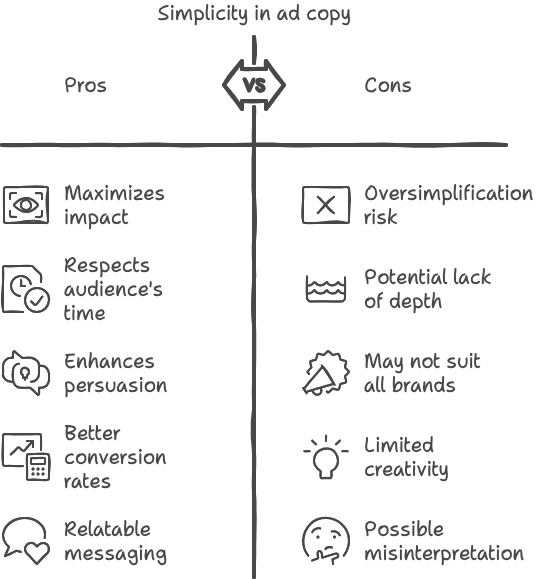
Check out Shane Snow’s research to learn more about the science of readability and how it impacts persuasion for ad copywriting tips.


